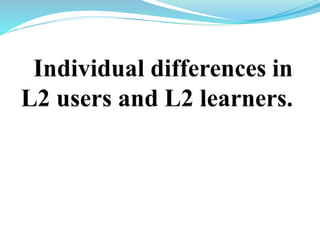
L2 Learning Motivation and Attitudes
- 2. Outline: - Motivation for L2 learning; - Motivation and teaching; - Attitudes; - Attitudes and language teaching.
- 3. - Children learn their L1 naturally in the intimate situations of their family; - Children learners learn an L2 formally in the public situation of the classroom.
- 4. Why did you learn a second language? What was the reason? Have you succeeded?
- 8. 0% 5% 10% 15% 20% 25% 30% 35% 40% To use on holidays abroad To use for work including travelling For peronal satisfaction To be able to work in another country To get a better job in your own country To be able to understand people from other cultures To meet people from other cultures To know a language that is widely spoken around the world To be able to study in another country
- 9. Motivation for L2 learning. Integrative motivation- learning the language in order to take part in the culture of it people; Instrumental motivation- learning the language for a career goal or other practical reason.
- 10. Studying a foreign language is important to my students, because they will be able to participate more freely in the activities of other cultural groups. (Integrative motivation) Studying a foreign language can be important for my students because it will some day be useful in getting a good job. (Instrumental motivation)
- 11. Integrative motivation related to actual contact with native groups, general attitudes and stereotypes. Instrumental motivation concerned with future careers. 2 factors relating to classroom learning: 1) The need for achievement; 2) Attributions about past failures. Zoltan Dornyei (1990)
- 12. Motivation and teaching. Ideal world of a teacher, when students: - Would enter the classrooms admiring the target culture and language; - Want to get something out of the L2 learning for themselves; - Eager to experience the benefits of bilingualism; - Thirsting for knowledge.
- 14. Attitudes What do you think are people’ s typical reactions to foreigners? To bilinguals? To monolinguals? Is it important to be able to speak two languages? Will you feel more yourself in your first language than in your second?
- 15. In additive bilingualism, the learners feel they are adding something new to their skills and experience by learning a new language, without taking anything away from what they already know. In subtractive bilingualism, the learners feel that the learning of L2 threatens what they have already gained for themselves. Lambert (1981, 1990)
- 16. Acculturation theory (Berry, 1998): 1) Is it considered to be of value to maintain cultural identity and characteristics? 2) Is it considered to be of value to maintain relationships with other group?
- 17. 0 1 2 3 4 5 Polish children Belgian children British adults British children Strongly disagree Strongly agree №1. Responses to “It is important to be able to speak two languages”.
- 18. Strongly disagree Strongly agree №2. Responses to “I will always feel more myself in my first language than in another language”. 0 1 2 3 4 5 Polish children Belgian children British adults British children
- 19. Strongly disagree Strongly agree №3. Responses to “People who go to live in a new country should give up their own language”. 0 0.5 1 1.5 2 2.5 3 Polish children Belgian children British adults British children
- 21. Are some people better at learning a Second language than others Why do you think some people are good at learning other languages? ‘Knack’ = learning languages Some people have more aptitude for learning second languages than others Aptitude has been applied to students in classrooms. Some people have a knack for learning second languages and others are rather poor Differences in L2 learning ability are only felt in societies where L2 learning is treated as a problem rather than accepted as an everyday fact of life
- 22. Young L2 learners VS old learners Children are believed to be better at learning second languages than adults. Children compared to adults encounter some factors and cognitive explanations Age is a positive advantage Adults start more quickly and then slow down, Children start more slowly and finish up at a higher level.
- 23. When should L2 teaching start? If they are intending to spend many years learning the second language, they might start as a child If they are going to learn the second language for a few years and then drop it, there is an advantage for adults who would reach a higher standard during the same period At particular ages students prefer particular methods.
- 24. Cognitive Style Refers to a technical psychological distinction between typical ways of thinking Two types- Field independent and Field dependant A difference in cognitive style might make a difference to success in L2 learning A tendency towards FI helps the student with conventional classroom learning. Cognitive style varies to some extent from one culture to another
- 25. Inividual Differences Intelligence Sex differences Level of first language Empathy
- 26. THANK YOU
